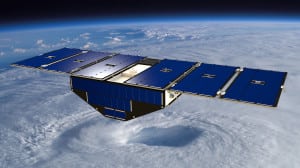Latest News
[Via Satellite 08-25-2015] The University of Michigan recently started building a constellation of eight microsatellites for use on NASA’s Cyclone Global Navigation Satellite System (CYGNSS) mission, which aims to improve hurricane forecasting. The mission, when launched in October 2016, will be the first in NASA’s history to make use of a constellation of small satellites, which have taken off in the commercial sector and are often affiliated with the “NewSpace” arena, but have seen little activity in government programs. With the technology seeing rapid maturation in the last five years, federal organizations now feel secure enough to employ SmallSat technology, which may offer major benefits to certain types of government missions.
“Because you can fly a lot of them, things that change quickly are amenable to CubeSat science,” explained Chris Ruf, CYGNSS principal investigator at the University of Michigan, which won the NASA contract to design and build the constellation in December 2012. “Extreme weather, storms, earthquakes, flooding, [and] hurricanes are all things that are getting looked at right now for future mission architecture studies.”
According to Ruf, the Department of Defense (DOD) and National Oceanic Atmospheric Administration (NOAA) are also looking into how to use satellites to lower costs and increase revisit time on satellite missions.
“Most of the small satellites 10 years ago were handmade by students in university labs. To do reliable science where you know the things are going to work for a while you need to have reliable technology. That hasn’t been around for very long with small satellites,” Ruf told Via Satellite. “This is something that NASA has been looking at and thinking about for a while, but now the technology is ready. Also, because they’re so small, you have to find a science payload that doesn’t require a lot of power, because small satellites only have a few tens of watts available for the science.”
Because the GPS payload that is planned to fly on CYGNSS requires such low power, the mission proved to be a prime example of how SmallSats can improve current undertakings and may substantiate the technology for future use.
When launched, the constellation aims to improve current hurricane forecasting by making measurements of ocean surface winds in and near the eye wall of tropical cyclones, typhoons, and hurricanes throughout their life cycle. Current satellite technology in orbit employs larger satellites with high frequency signals to measure the wind via the roughness of the ocean surface. But these current satellites are limited in two main ways: the high frequencies don’t have the ability to see through rain, meaning scientists lose their ability to monitor a hurricane when it begins to intensify, and, because they are larger and more expensive to build and launch, fewer numbers in orbit limit revisit times to every one or two days.
“Those were the two things we wanted to improve on with CYGNSS,” Ruf said. “Because the constellation uses GPS signals, which are a really low frequency, they can penetrate through rain and they can see fine in the middle of a hurricane. And, because the technology for these little GPS receivers is so small, we can put them on smaller satellites and we can afford to fly lots more satellites. If you have a lot of smaller satellites, you can monitor an area every few hours as opposed to every day or two. With this technology, we can see those short timescale changes in the weather.”
According to an Aug. 19 NASA press release, CYGNSS’ configuration will allow scientists to probe the inner core of a hurricane from space for the first time by using both direct and reflected signals from existing GPS satellites that will obtain estimates of surface wind speeds over the ocean. This ability to predict rapid changes in hurricane intensity with more accuracy and frequency could dramatically influence the foresight that forecasters and affected coastal communities have when preparing for a storm.
“It’s not such a big impact on predicting where the hurricane is going to go, but it’s a strong impact on estimating how strong the hurricane is going to be in the future when you add in the ability to see through rain and to see more often. With that, we’re hoping the intensity forecast will get a lot better,” said Ruf.
CYGNSS passed two major milestones earlier this summer — the Critical Design
Review (CDR) and the System Integration Review (SIR) — clearing the way for the University of Michigan to begin integrating, testing, and preparing the constellation for flight. Assembly of the first 20-by-25-by-11-inch microsatellite began just last week with the next seven to follow in coming weeks. Each microsat will weigh roughly 64 pounds when fully assembled, with a wingspan of 5.5 feet with the solar panels deployed.
The satellites are scheduled for launch aboard an Orbital ATK Pegasus XL expendable rocket from Cape Canaveral, Fla., in late 2016. The plan is to have the constellation calibrated and ready to perform operational science by the 2017 Atlantic hurricane season. Should the $150 million mission prove successful, CYGNSS could lead the way for microsat technology at NASA in the future.
“In terms of CubeSats in general, in a lot of ways this is kind of a pathfinder for NASA to show that you can do real science using these small satellites,” added Ruf. “The expectation is, if we do a reasonable job, it will become a lot more commonplace in the future.”
Get the latest Via Satellite news!
Subscribe Now